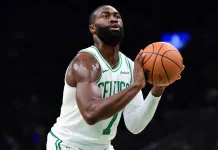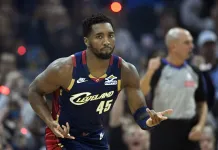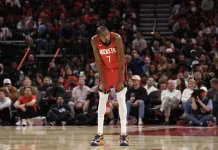Attention lovers of defenseless exhibitions: the NBA All-Star Game comes Sunday. It will the fifth straight season in which the league separates in best players in a format in which two captains pick the rosters. It’s Team LeBron versus Team Durant, as LeBron James’ group matches up against Kevin Durant’s picks. James is looking to run his All-Star winning streak to five games. By the looks of the rosters, he’s in good position to extend that streak.
It takes a certain mindset, particularly when the college basketball action is heating up, to commit to watching and wagering on the spectacle that is the NBA All-Star Game. That said, it is the only game on the NBA board one day each winter, so most bettors are inclined to take part in the action. I will caution you that I have not watched this game in more than five years and will not do so once again. However, there is no denying the success of the quantitative system I have developed that analyzes the rosters and projects a point spread and who should win. It has been very successful as the overall record of my system over the last 11 years has been 8-3 SU and 7-3-1 ATS.
A year ago, Team LeBron (-4.5) beat Team Durant 170-150 on a total of 319.5. Talk about a sharply set total by oddsmakers. Of note, the game going Over the total advanced the record of that betting option to 13-2 in the last 15 games. That shouldn’t come as a surprise, and I pity anyone who bets this exhibition Under the total and then chooses to watch it. In terms of sides, favorites have won seven straight games outright while going 5-1-1 ATS.
This year’s game will be played in Cleveland for the first time since 1997, at Rocket Mortgage FieldHouse, where “King James” used to reign. Assuming there are no more late-breaking injuries, opt-outs or positive COVID-19 tests, the only one of the teams’ voted-in starters who won’t be available is Durant, for the second straight season. Also, Jarrett Allen of the hometown Cavs was selected to Team LeBron as the replacement for James Harden, who is out with a hamstring strain.
Usually shortly after the rosters are announced, the game odds are released. For whatever reason that did not happen this year, so you’ll have to take my projections and use them against the actual odds when they come out.
James used his first pick to choose Giannis Antetokounmpo (Bucks), the MVP a year ago for both this game and the NBA Finals. The Greek Freak put up 35 points on 16-for-16 shooting in just 19 minutes. The two will be joined in the starting lineup by Stephen Curry (Warriors), Demar DeRozan (Bulls) and Nikola Jokic (Nuggets). The Durant team counters with a starting group of Joel Embiid (76ers), Ja Morant (Grizzlies), Jayson Tatum (Celtics), Andrew Wiggins (Warriors) and Trae Young (Hawks). You can find the reserves in the chart below detailing each of the rosters and the process I use. On the surface, it would once again appear that the starting lineup of Team LeBron is superior, boasting the two most recent league MVPs. Finding out for sure is where my increasingly popular player evaluation system comes into play.
So who wins this year’s game? Who should we bet on? Most often, it comes down to these questions: 1. Which roster is better? And 2. Which team will play with more cohesiveness?
While it is impossible for anyone to know enough about No. 2 other than pure speculation, it is possible to evaluate the first question. This can be done both quantitatively and from a perception standpoint.
I have used this same formula to determine which roster was more talented in all of the recent NBA All-Star Games.
The formula involves taking into account the popular Hollinger Ratings on ESPN.com used for evaluating Player Efficiency (PER). I then estimate the minutes the starters and reserves will play based on recent games and have come up with a theoretical TOTAL TEAM EFFICIENCY RATING that I use to justify a point-spread play for Sunday’s game.
According to the results, assuming the minutes played breakdown is somewhat near accurate (it has always been pretty close), the Team LeBron roster is slightly better in terms of cumulative player efficiency ratings, by about 3.1%. However, it should be noted that younger players received a little more playing time than usual last year. I have adjusted my projections accordingly.
The “total PER” projected for this year’s game is LeBron 5844.2, Durant 5383.37. In other words, Team LeBron is projected to be about 8.6% better. That comes just short of the 2019 and 2020 projected disparities for his teams (%plussign% 8.7%, %plussign% 9.1%), which were the widest my projections have ever been. In other words, this game tilts pretty heavily to Team LeBron. If we see a similar total to last year’s game of 319.5, an 8.6% difference would result in a score of:
Team LeBron 166.3
Team Durant 153.2
Theoretically, a point spread of LeBron -13.1. I’m quite sure it will not get that high, so I will be comfortable laying anything up to double digits.
In 2020, I called for not backing Team Giannis at anything less than an underdog line of %plussign% 7 or more. Ironically, that’s where the final line settled at, and Team Giannis covered. Keep in mind, though, Team LeBron did not play its starters anywhere near the usual expectation. The prior year was an easy favorite cover for Team LeBron (-4.5), a game I called drastically underpriced.
In last year’s game, my projection had Team LeBron favored by 4.7 points, Another win, as it closed as 4.5-point favorites. When Mike Conley was subbed in late for Devin Booker and Embiid had to miss due to COVID tracing on Durant’s team, the projection bumped up much further for Team LeBron, to 5.5.
The rules for this year’s game are the same as last year and should be considered before finalizing your bets, as they could throw you off, especially on the total when you consider the “24-point rule.” Here are a few of the key “competitive rule” highlights:
— Each of the first three quarters will begin with a score of 0-0 and will last 12 minutes. The winner of each 12-minute quarter (first, second and third) will be the team that scores the most points within that quarter.
— At the start of the fourth quarter, the game clock will be turned off and a Final Target Score will be set. Once the Final Target Score is set, the teams will play an untimed fourth quarter, and the first team to reach (or surpass) the Final Target Score will win the game.
— The Final Target Score will be set by adding 24 points (Kobe Bryant's old uniform number) to the total of whichever team has the lead through three quarters (i.e. if the team with the lead has 100 points, the target score would be 124). The first team to reach that target would win the game.
Good luck on your NBA All-Star wagering and enjoy the spectacle. And remember, if you prefer sound, fundamental basketball, there will be some college games on TV, or maybe a youth basketball tournament going on at a gym near you.





